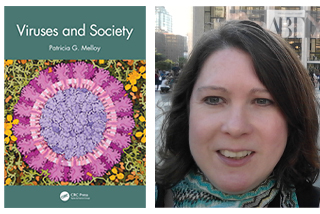Viruses and society
"Viruses and Society" is a textbook written by Patricia Melloy, professor of biological sciences, Fairleigh Dickinson University

“Viruses and Society” is geared toward professionals and students in college-level introductory biology courses devoted to understanding viruses, vaccines and their global impact. In approachable and simplified language, the book introduces cells, DNA and viruses themselves. This is followed by a review of how the immune system works and how scientists and physicians harness the immune system to protect people through vaccines. Specific chapters focus on the 1918 influenza pandemic, the fight to eradicate polio, the HIV/AIDS pandemic and the current COVID-19 crisis. Additionally, the book reviews the uses of viruses in genetic engineering and gene therapy. It concludes by describing public health initiatives to keep emerging viruses in check and the role of scientific communication in how viruses are perceived and have an impact on our society.
CRC Press
Are you an ASBMB member who has published a book recently?
If so, we’d like to feature your work in an upcoming issue of ASBMB Today. Please email a synopsis (under 100 words), an image of the book’s cover and your headshot to ASBMB Today.
Enjoy reading ASBMB Today?
Become a member to receive the print edition four times a year and the digital edition monthly.
Learn moreGet the latest from ASBMB Today
Enter your email address, and we’ll send you a weekly email with recent articles, interviews and more.
Latest in People
People highlights or most popular articles

Mydy named Purdue assistant professor
Her lab will focus on protein structure and function, enzyme mechanisms and plant natural product biosynthesis, working to characterize and engineer plant natural products for therapeutic and agricultural applications.

In memoriam: Michael J. Chamberlin
He discovered RNA polymerase and was an ASBMB member for nearly 60 years.

Building the blueprint to block HIV
Wesley Sundquist will present his work on the HIV capsid and revolutionary drug, Lenacapavir, at the ASBMB Annual Meeting, March 7–10, in Maryland.

In memoriam: Alan G. Goodridge
He made pioneering discoveries on lipid metabolism and was an ASBMB member since 1971.

Alrubaye wins research and teaching awards
He was honored at the NACTA 2025 conference for the Educator Award and at the U of A State and National Awards reception for the Faculty Gold Medal.

Designing life’s building blocks with AI
Tanja Kortemme, a professor at the University of California, San Francisco, will discuss her research using computational biology to engineer proteins at the 2026 ASBMB Annual Meeting.
